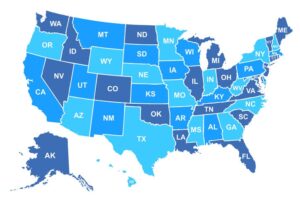How Do I Register for Medicare?

If you’re under 65 and curious about registering for Medicare, the process is relatively straightforward. First, it’s essential to determine if you qualify for Medicare due to a disability or specific health conditions.
In this article we’ll discuss:
Generally, individuals under 65 can apply if they have been receiving Social Security Disability Insurance (SSDI) for at least 24 months. If they have certain medical conditions like End-Stage Renal Disease (ESRD) or Amyotrophic Lateral Sclerosis (ALS), they can apply.
Once your application is submitted, you will receive a confirmation regarding your eligibility and benefits.
How Do I Register for Medicare?
To register for Medicare, you first need to determine your eligibility. Generally, individuals who are 65 years old or older, or those who have certain disabilities, can apply. You can sign up during the Initial Enrollment Period (IEP). This begins 3 months before your 65th birthday and lasts for seven months.
To begin the registration process, visit the Social Security Administration website or call their office. You can also apply in person at your local Social Security office. During the application, you’ll need to provide personal information. Your Social Security number, date of birth, and details about your work history will be needed.
Once you submit your application, you will receive a Medicare card in the mail. It’s important to review your options, including Medicare Part A and B. You need to ensure you select the coverage that best meets your healthcare needs.
When Should You Register for Medicare?
When you are considering getting social security benefits, it’s crucial to understand when to get started with Medicare. Most individuals become first eligible for Medicare on their 65th birthday. You can get Part A automatically if you’re already receiving SS benefits. If you aren’t, you’ll need to apply for benefits. The Medicare registration process allows you to sign up and get Part A and Part B during a designated period.
Specifically, you can sign up for Part B within the 3 months before your 65th birthday and up to 3 months after. If you’re getting disability benefits, you may get signed up for Medicare after 24 months of receiving them.
Keep in mind that if you miss the sign up period, you may have to pay a monthly late enrollment Penalty. Therefore, it’s best to start your preparations at least 3 months before your Medicare eligibility.
What is the Initial Enrollment Period?
When considering when you should register for Medicare, it’s essential to understand the application process for Part A and B. You’ll typically get Medicare automatically if you’re already getting SS benefits at least four months before you turn 65. If you’re not receiving these benefits, you should sign up during your IEP (begins three months before your 65th birthday). This is the fastest way to sign up and get Medicare Part A and Part B coverage.
If you are under 65 and get disability benefits, you will also qualify for Medicare after 24 months of receiving those benefits. Additionally, if you miss your window, you may have to pay a monthly late penalty when you do finally apply for benefits. It’s crucial to get started with Medicare as soon as you are eligible.
What happens if you miss the enrollment period?
If you miss the registration window for Medicare, your options may become limited. Typically, if you are turning 65, you can get part A automatically if you are already receiving benefits from SS. However, if you want to sign up based on your situation for part B, you will need to do so within 3 months of the month you turn 65. If you miss this window, you might have to wait until the next General Enrollment Period (GEP). This may delay the start of your coverage.
For those under 65 with qualifying conditions like amyotrophic lateral sclerosis (also called Lou Gehrig’s disease), you can get part B automatically. However, you must ensure you have applied correctly.
It’s crucial to prepare in advance. If you are eligible for parts A & B and miss your registration window, you may not be able to get enrolled immediately. To avoid complications, it is advisable to create your secure account with the Social Security Administration. Do this at least 4 months before your 65th birthday. This will ensure you can manage your application effectively and start getting benefits from social services without unnecessary delays.
How to Register for Medicare
As you approach age 65, it’s essential to understand how to register for Medicare. If you’re already receiving retirement benefits from SS, you’ll be automatically signed up for Medicare when you turn 65. This means you’ll get Part A and Part B coverage without needing to take any action. However, if you don’t sign up for Part B within 3 months of your 65th birthday, you may face penalties. If you already have Part A, you can apply online to get Part B as well.
The easiest and fastest way to manage your registration is online. You can sign up for Original Medicare and explore options for a prescription drug plan. If you didn’t sign up during your IEP, keep in mind that you may be eligible during the GEP, which starts 4 months before turning 65 or during special enrollment periods (SEP). What documents do I need to apply for Medicare?
To sign up for original Medicare, you need to understand the process, especially if you’re approaching 65. Most people are automatically signed up for Medicare if they already get benefits from Social Security. However, if you don’t, you must apply for Medicare online during your IEP, which begins 4 months before your 65th birthday and lasts for 3 months after your birthday. If you want Part B, you should sign up for Part B within 3 months of your 65th birthday to avoid penalties.
For those who already have Part A, it’s important to know that you may also want to get a prescription drug plan to cover medications. If you didn’t sign up for Part B when you were first eligible, you may be eligible for an SEP. Understanding how Medicare works is crucial for maintaining your health coverage. If you’re under 65, you’ll need to wait until you turn 65 or qualify for certain retirement benefits to obtain Medicare.
Where can you register for Medicare?
If you’re looking to register for Medicare, there are several options available to you. For individuals who are nearing age 65, you can sign up for Medicare during the IEP, which begins three months before your 65th birthday. This includes getting Part A, which starts your coverage for hospital services. However, if you are under 65 and qualify due to a disability or certain medical conditions, you can also register for Medicare through the SSA.
To apply, you can visit your local Social Security office, call their toll-free number, or use the online application available on the Social Security website. During the registration process, you’ll have the option to enroll in either Part A or Part B, depending on your healthcare needs. It’s essential to understand the differences between the two parts to ensure you choose the right coverage for your situation.
Can you register for Medicare online?
Yes, you can register for Medicare online, which makes the process convenient and accessible for many individuals. If you are approaching eligibility, it’s important to understand that Part A begins automatically when you turn 65, provided you have worked and paid Medicare taxes for at least ten years. However, if you are under 65 and qualify due to a disability or specific medical condition, you can also go online to apply. The online application is straightforward, guiding you through the necessary steps to ensure you receive the benefits you need.
To begin the registration process, you can visit the official SSA website, where you can complete your application securely. It’s advisable to have your personal information and supporting documents ready, as this will help expedite your application. Once submitted, you should receive confirmation and details about your coverage options, including when your Part A starts.
What to Expect After Registration
After you complete the registration process, you can expect a seamless transition into the next phase of your journey. Part A starts with a comprehensive overview of the services available to you. This initial stage will provide you with essential resources and information tailored to your needs. For individuals like me who are under 65, there will be specific programs and benefits designed to cater to younger participants.
As you move forward, keep an eye on any follow-up communications that may include important updates or additional steps to take. You’ll likely receive access to personalized tools that can help you navigate your options effectively.
Overall, the registration process is just the beginning, and the support you receive will be instrumental in maximizing your experience. Be sure to engage with the resources provided to ensure you make the most of what is offered to you.
How will you receive your Medicare card?
As someone who is under 65, the process of receiving your card will differ slightly compared to those who are older. Typically, you will become eligible for Medicare if you have a qualifying disability or specific health conditions. Once you qualify, you will be automatically enrolled in Medicare after you’ve received your SS benefits for twenty four months.
Your card will be mailed to you about three months before your 25th month of receiving those benefits. The card will arrive at your home address, so it’s essential to ensure your information with Social Security is up to date. If you haven’t received your card by that time, you can contact the SSA for assistance.
Once you receive your card, it’s crucial to review the details for accuracy. Keep your Medicare card in a safe place, as you will need it to access your healthcare services.
What should you do if you don’t receive your card?
If you find yourself in a situation where you haven’t received your card, the first step is to check the status of your application. Contact the issuing organization to confirm whether your card has been processed and dispatched. If you’re under 65, it’s important to ensure that you meet all eligibility criteria that may impact card issuance.
Additionally, review any communication you may have received to verify if there are any outstanding issues or further information required from your end. Should you discover that your card has been lost or stolen, report this immediately to prevent unauthorized use. Finally, be persistent in following up with customer service; sometimes, a simple inquiry can expedite the resolution of your card issue.
Understanding Medicare
Understanding Medicare can be crucial for those approaching retirement or dealing with disabilities. If you want to sign up for Medicare, it’s important to know that people get Medicare automatically if they’ve been receiving SS benefits for at least twenty four months. For those under 65 who qualify for disability benefits from social security, you can apply for Medicare and get benefits without any penalties. Part A provides hospital insurance, while Part B covers outpatient services.
If you decide you want Part B, you need to sign up for Part B within the first three months of your eligibility, or you may face late penalties. You can enroll online or through the Railroad Retirement Board if applicable. A welcome package with your Medicare card will be sent to you, detailing your Medicare coverage, including options like Medigap or MA (Part C).
For those who are eligible for end-stage renal disease (ESRD) or ALS, you can get Medicare coverage without the typical waiting period. Remember, if you wait to sign up for Part B when you turn 65, your Medicare coverage starts only after you’ve completed the Medicare enrollment process. Staying informed and understanding these options can help you make the best choices for your healthcare needs.


